Welcome to the group of death of this season’s UEFA Champions League. Barcelona, Dortmund, Internazionale, and Slavia Praha are going to fight against each other to clinch two knockout spots out of Group F. The group started with a bang in Italy where Internazionale needed an injury-time goal to salvage a point against Slavia Praha.
A shocking result in Italy just raised the hype for this game. Dortmund and Barcelona came to this match with different moods. The home side had scored nine goals and conceded none in their last two games while the away side only managed to bag two victories in their opening four league matches. On top of that, Lionel Messi was not fully recovered from his injury ahead of this encounter and had to start the game from the bench.
Surprisingly this game ended with no goals; credit to Marc-André ter Stegen’s heroic performance and Dortmund’s bluntness in front of goal. However, there were some interesting tactical approaches deployed by both managers in this match. This tactical analysis will inform you how both teams approach the game with their tactics.
Lineups
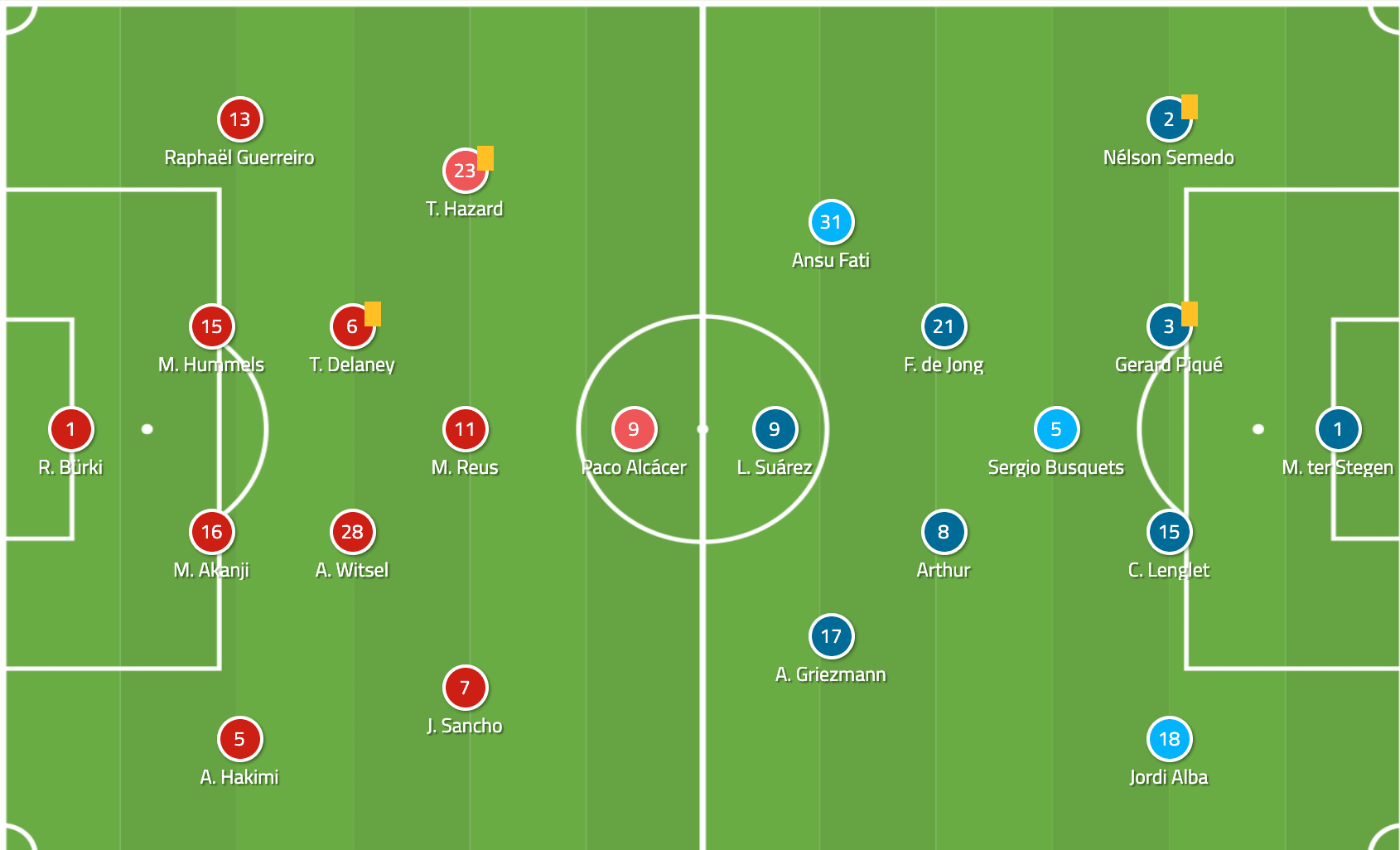
Lucien Favre set his team up in 4–2–3–1. Former Bayern player Mats Hummels started alongside Manuel Akanji as Dortmund’s centre-back pairing. As for the home sides attacking outlets, talisman Marco Reus was flanked by English sensation Jadon Sancho, and new recruit Thorgan Hazard; with Paco Alcácer leading the frontline. The bench was filled by names like Mario Götze, Jacob Bruun Larsen, and another new recruit in Julian Brandt.
In the opposite side, Ernesto Valverde opted for 4–3–3. Midfield general Sergio Busquets was supported by Arthur, and former Ajax player Frenkie de Jong. The trio of Antoine Griezmann, Luis Suárez, and 16-year-old sensation Ansu Fati started upfront. Partially healed Messi, versatile Sergi Roberto, and Ivan Rakitić had to start the game from the dugout.
Barcelona with the ball, Dortmund with the wall
In this part of the analysis, we are going to look at both teams’ main shapes throughout the match. As expected, Barcelona enjoyed the lion share of possession, especially in the first half. Offensively, Barcelona used 3–3–4-ish shape when they got the ball. At the back, Nélson Semedo came inside alongside Gerard Piqué and Clément Lenglet to form a temporary back-three while Jordi Alba went up and provide width in the left flank.
Upfront, Griezmann and Fati had different roles. Griezmann would tuck inside and play inside the half-space to make easier combination routes with Suárez and Arthur, while Fati provided the width in the right flank. To disrupt Dortmund’s defence, Griezmann and Fati would rotate their positions and roles quite often throughout the game.
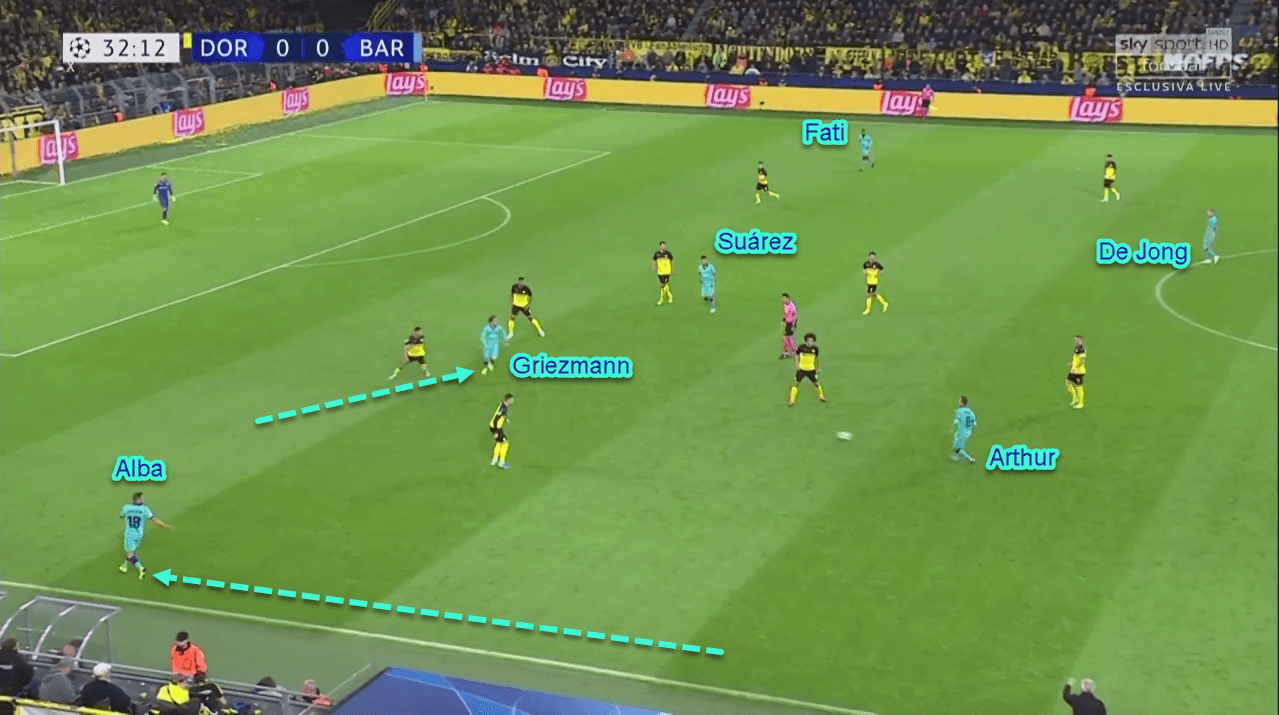
Oppositely, Dortmund opted for a safer approach. Favre set his team up in a mid-block 4–4–2 without the ball, and team captain Reus joined Alcácer in Dortmund’s first defensive line.
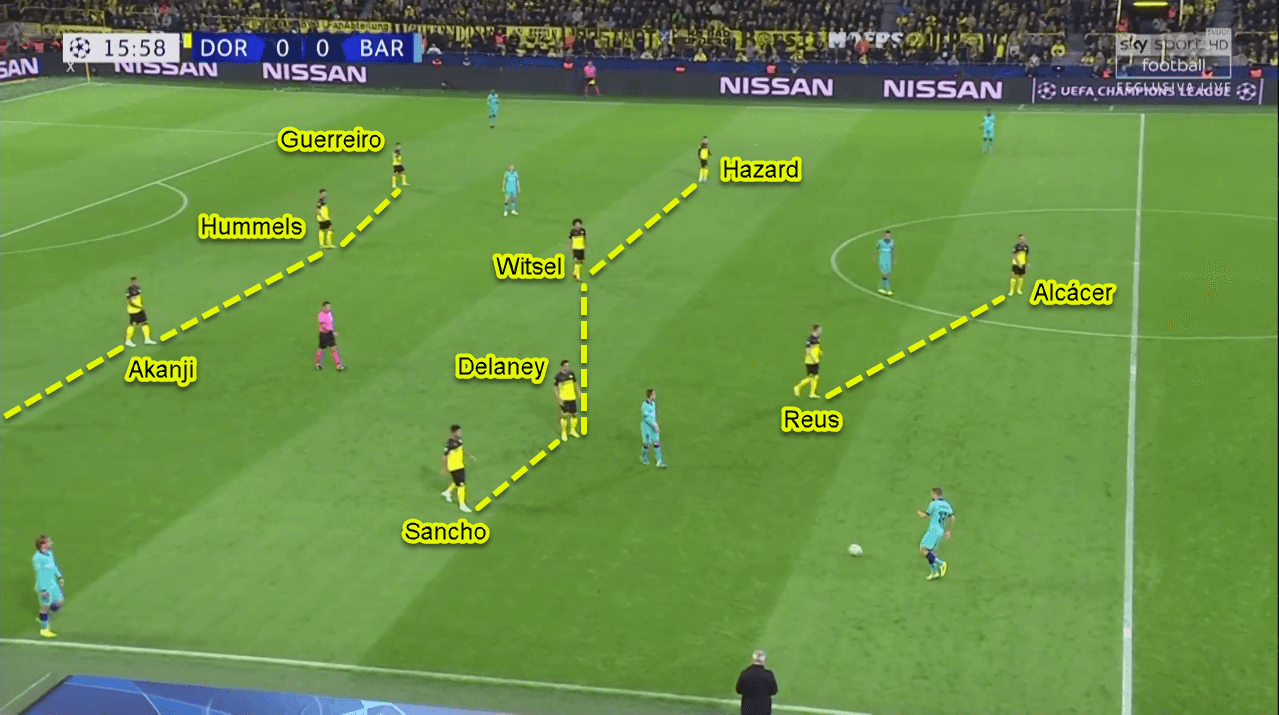
Battle for space
Dortmund’s 4–4–2 was very compact. They tried to squeeze the space in between the lines and force Barcelona to play wide. They did that by only allowing about 10 metres between their defensive and midfield lines. Not only that, but they were also horizontally compact and didn’t allow Barcelona to play inside the channels.
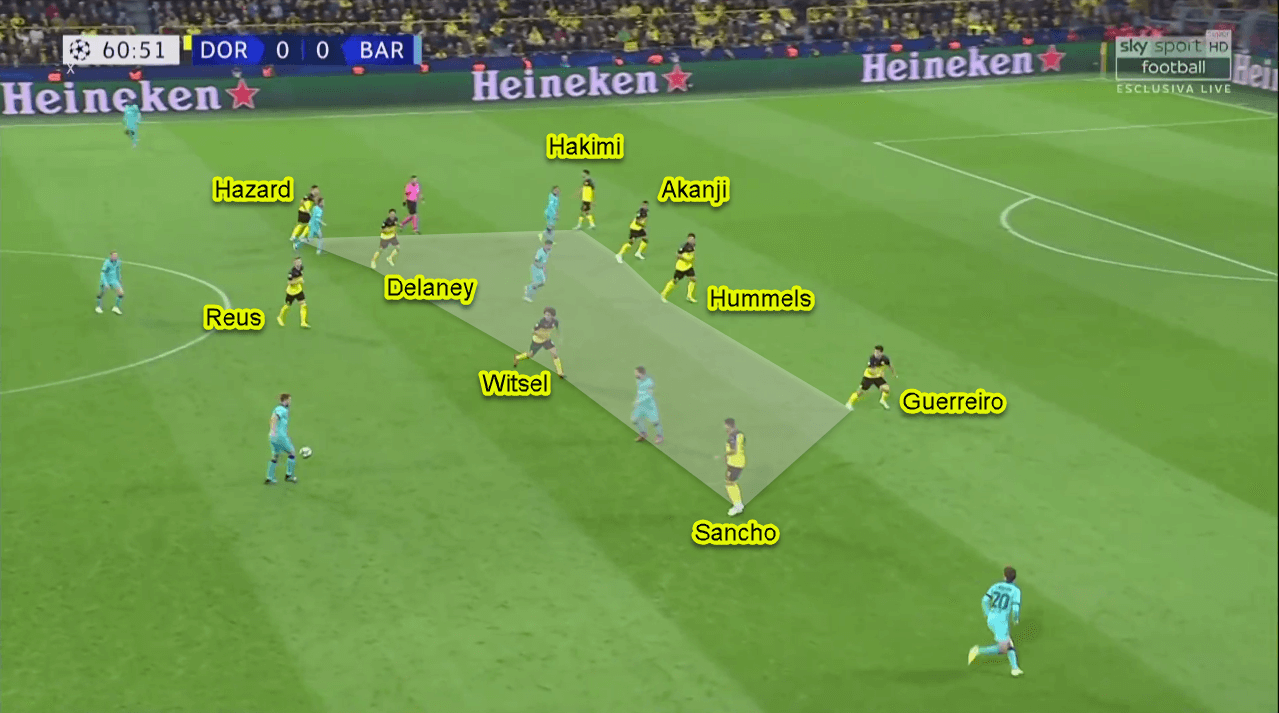
However, Barcelona found an interesting way to exploit and attack the space between Dortmund’s lines. They did that firstly by putting their attackers inside the same half-space. In that area, they could make an overload, combine, and eventually free one attacker to attack the space.
In the process, Valverde gave different tasks to his forwards. Fati was tasked to drop alongside the midfielders inside the space between the lines, so they could make a 4 v 2 overload against Dortmund’s double pivot. Suárez was instructed to pin the defensive line by putting himself in between or against one of the centre-backs. Griezmann was tasked to drift a bit wider so he could start his driving run from the blind-spots of Dortmund’s midfielders.
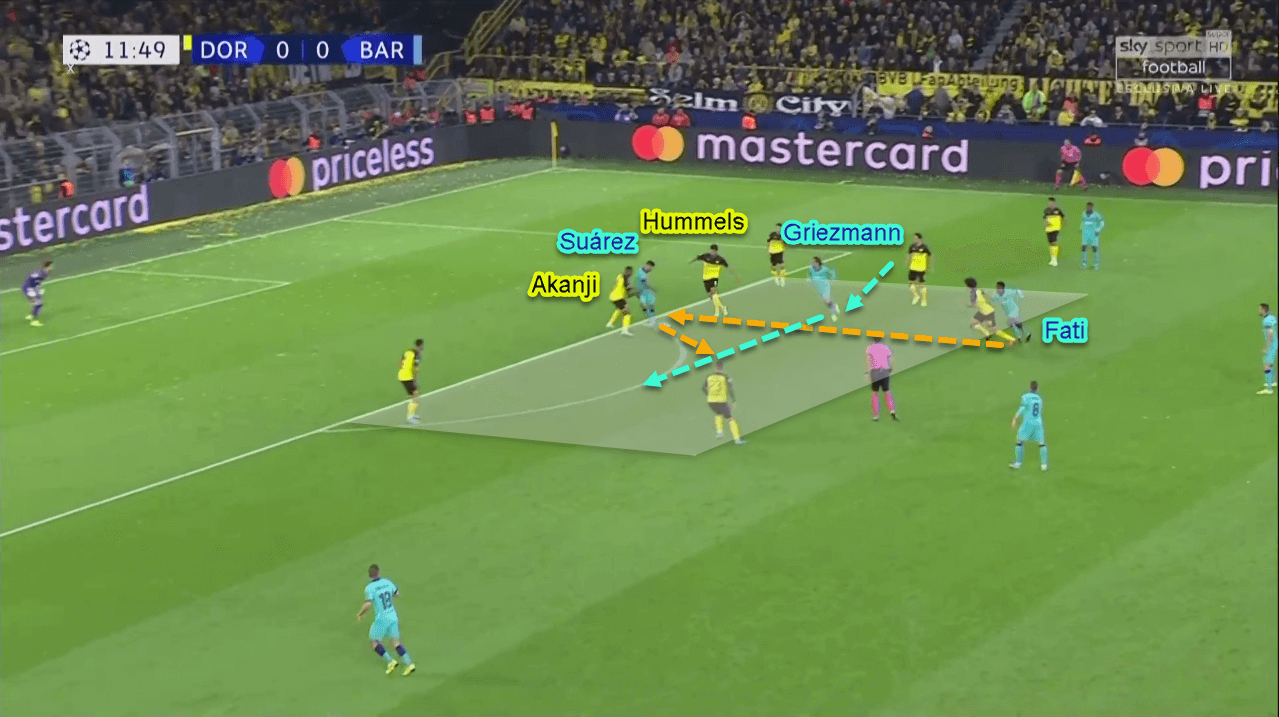
In the sequence, Fati (or one of the midfielders) utilised the overload and make a forward pass to Suárez’s feet. When the pass was being made, Griezmann started his driving run into the space. Suárez — holding the centre-back(s) — then laid the ball off into Griezmann’s running path with his first touch. Taking advantage of the momentum, Griezmann would have enough space and time to create a chance for himself.
Barcelona off the ball
As expected, Barcelona don’t like their opponents to have the ball and would prevent Dortmund from building their plays smoothly from the back. To do so, Barcelona used a man-oriented pressing high up the pitch. They did that by closing nearby passing options for the man on the ball, which forced Dortmund’s defenders to play more ineffective direct balls in their build-ups. However, they didn’t press all the time and opted to sit in a mid-block 4–1–4–1 when Dortmund were active on the ball.
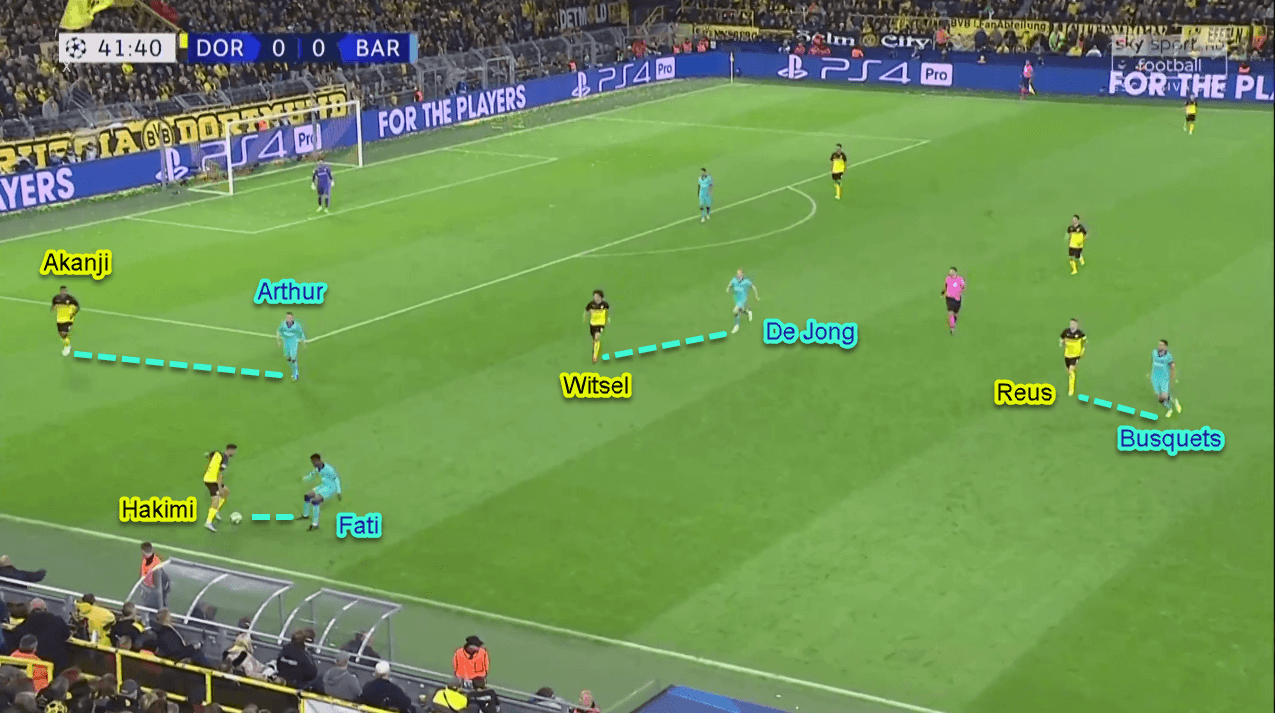
In the 4–1–4–1, Busquets played as the lone defensive midfielder while De Jong and Arthur stepped up alongside the wingers. However, their 4–1–4–1 shape was not compact vertically. This gave an issue for the away side since Busquets had to cover a lot of ground while focusing on Reus at the same time. Lucky for Barcelona, both Dortmund’s wingers hugged the touchline and rarely came inside to make an overload in between the lines with Reus.
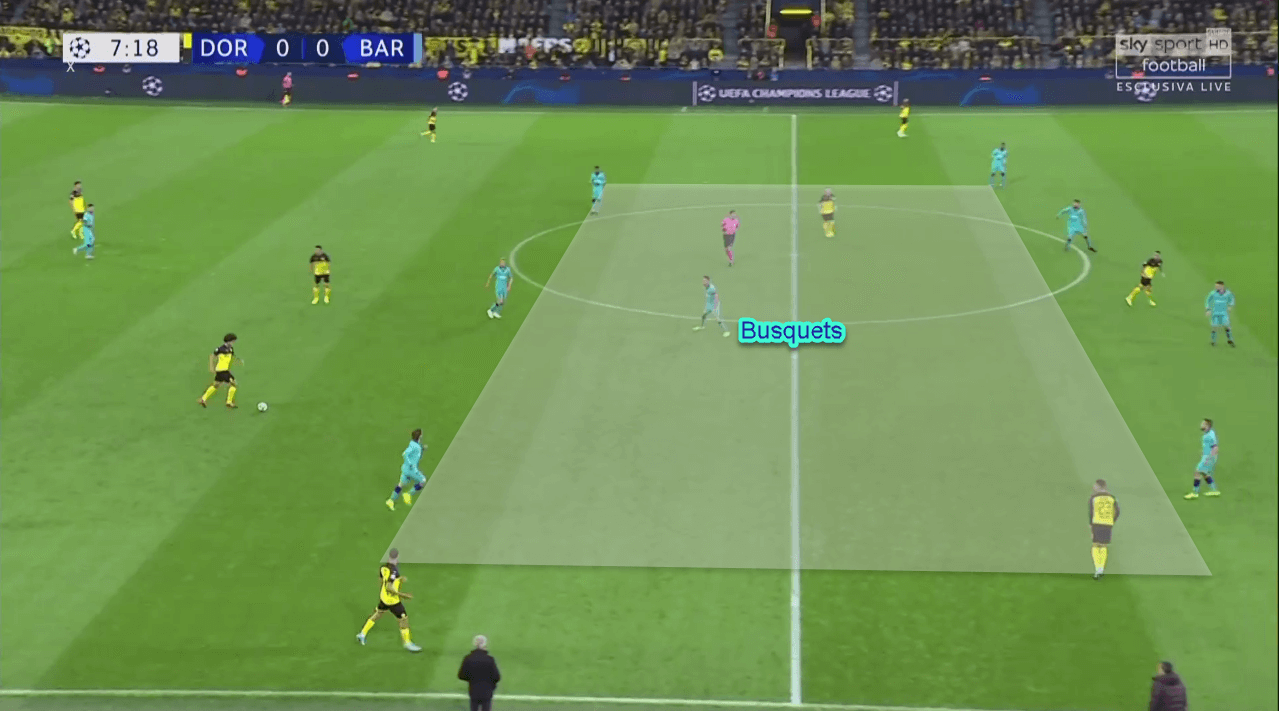
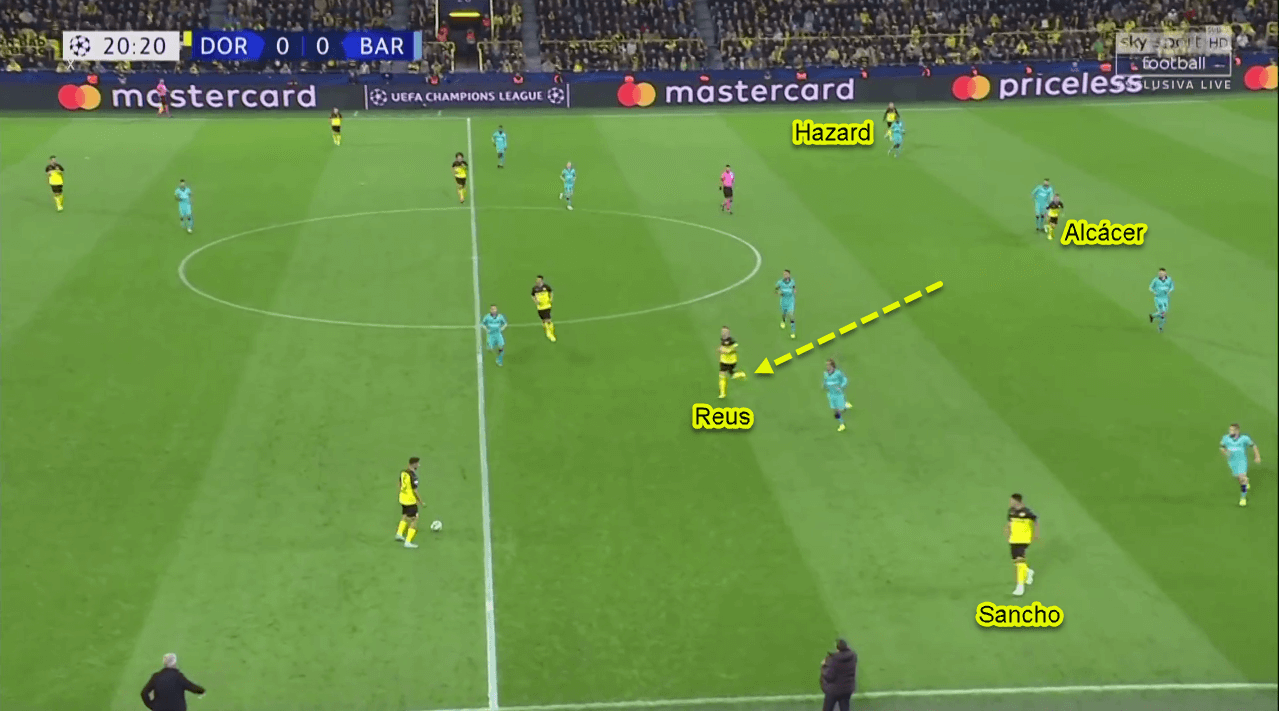
Busquets did have little problems in the first half
Although not by their wingers, Dortmund gave Busquets a little headache in the first half. Their objective was opening a clear forward passing lane for one of the centre-backs (mainly Akanji) to Alcácer. The striker then could combine with Reus in between the lines after receiving. Here’s how Dortmund pulled the move.
Mainly, Reus would drift into one half-space from the central lane. By doing so, he would drag Busquets out of his position and allowing Alcácer to drop a little bit. Reus’ movement then would open clear passing lane for Akanji to find Alcácer. In addition to this approach was Dortmund’s midfielders’ movements. Same like Reus, Thomas Delaney and/or Axel Witsel would drift away from the central lane and pull De Jong and/or Arthur with them.
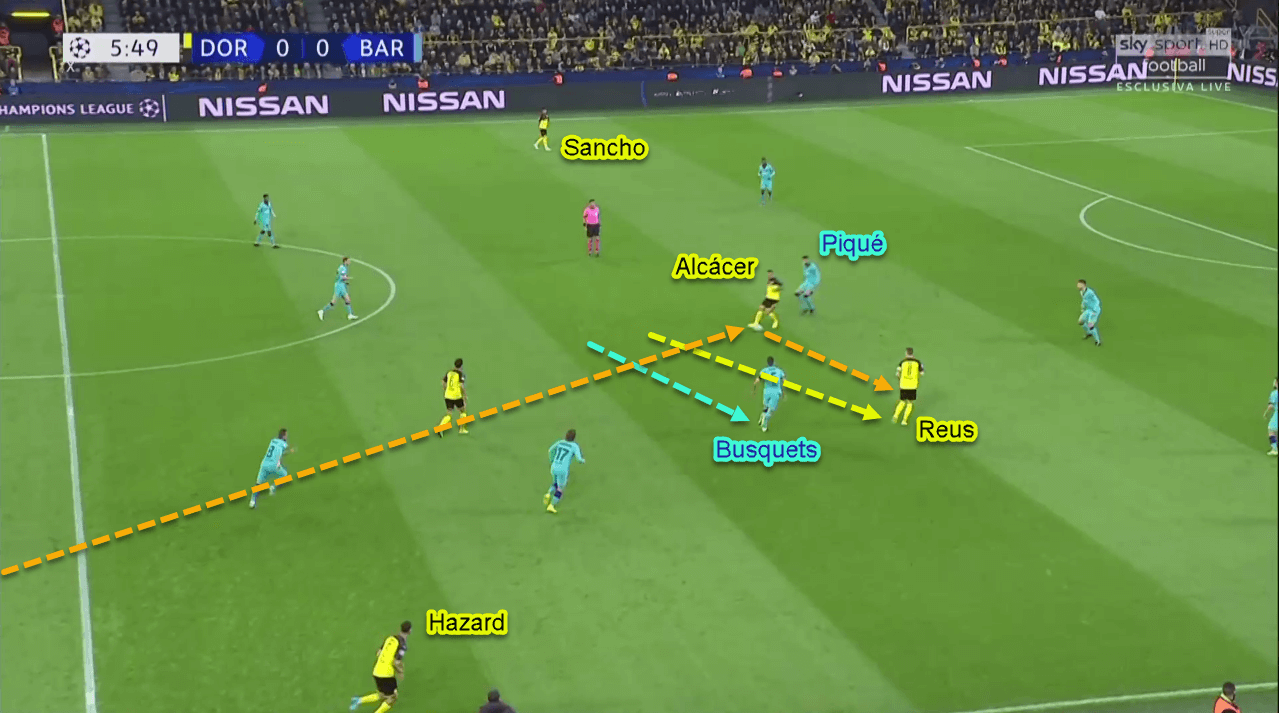
Even so, the damage Dortmund made was not severe, as Reus would have little to no option after receiving from Alcácer. The striker himself was facing his own goal when laying the ball off to Reus, making him ineligible to combine. On top of that, none of the wingers were close enough to support Reus.
Dortmund create chaos in behind
Although Favre’s central-focused approach didn’t work, he had a more deadly alternative for his attackers. In fact, this route gave Dortmund at least three clear-cut chances throughout the match, which could have ended in goals had they not forgotten to wear their shooting boots. Here’s how the strategy worked.
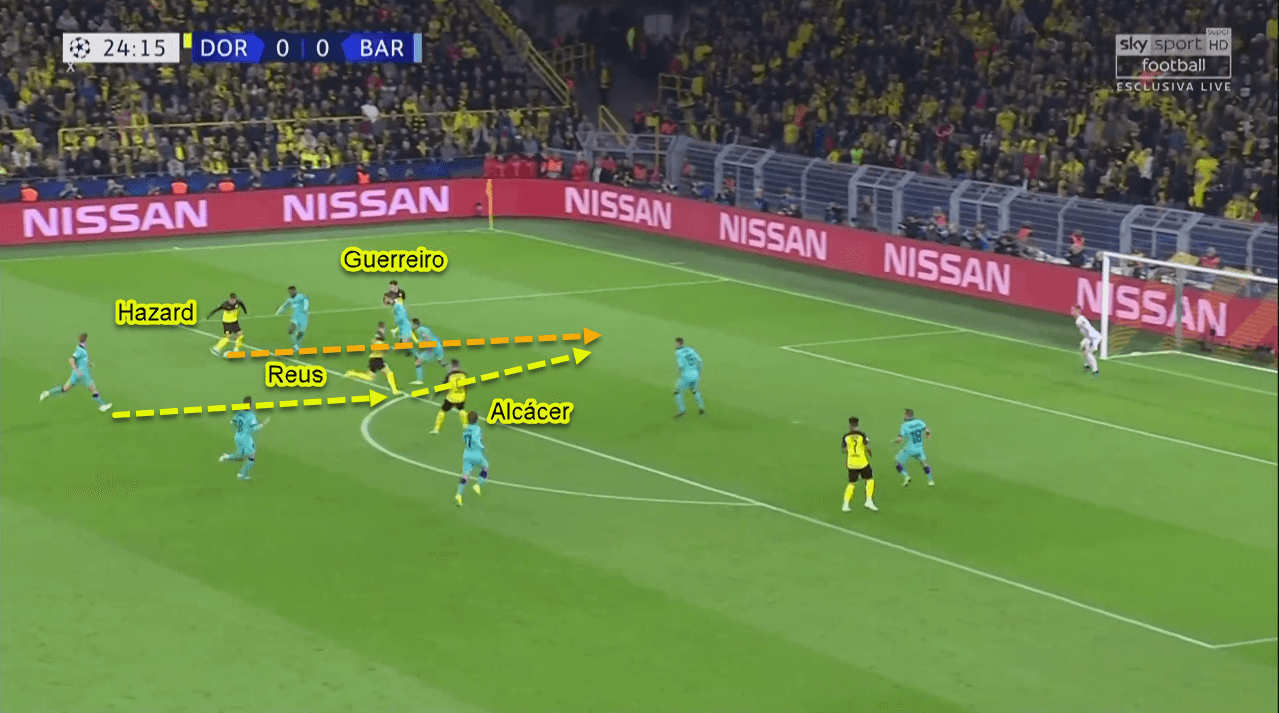
In this set-up, Favre would ask his men to make an overload on one side- particularly in the half-space. He tasked the full-back to go up next to the winger as well as instructing Reus to come into that half-space. In that area, the trio could combine between each other and finally releasing one of them in behind with a sharp pass. The receiver then would make a cutback pass or a grounded cross to one of his teammate inside the box or even create a chance for himself.
Another way Dortmund used to create chaos was by releasing the winger inside the half-space in behind with the full-back’s help or vice versa. The Dortmund full-back with the ball was on the flank, dragging Barcelona’s full-back with him while leaving the half-space empty. No Barcelona players came to defend that space, the centre-back couldn’t leave his partner alone against Reus and Alcácer inside the box. On top of that Barcelona’s ball-near midfielder and winger didn’t track the aggressive run of the Dortmund’s winger, thus leaving the winger free to receive the ball and send it into a dangerous area.
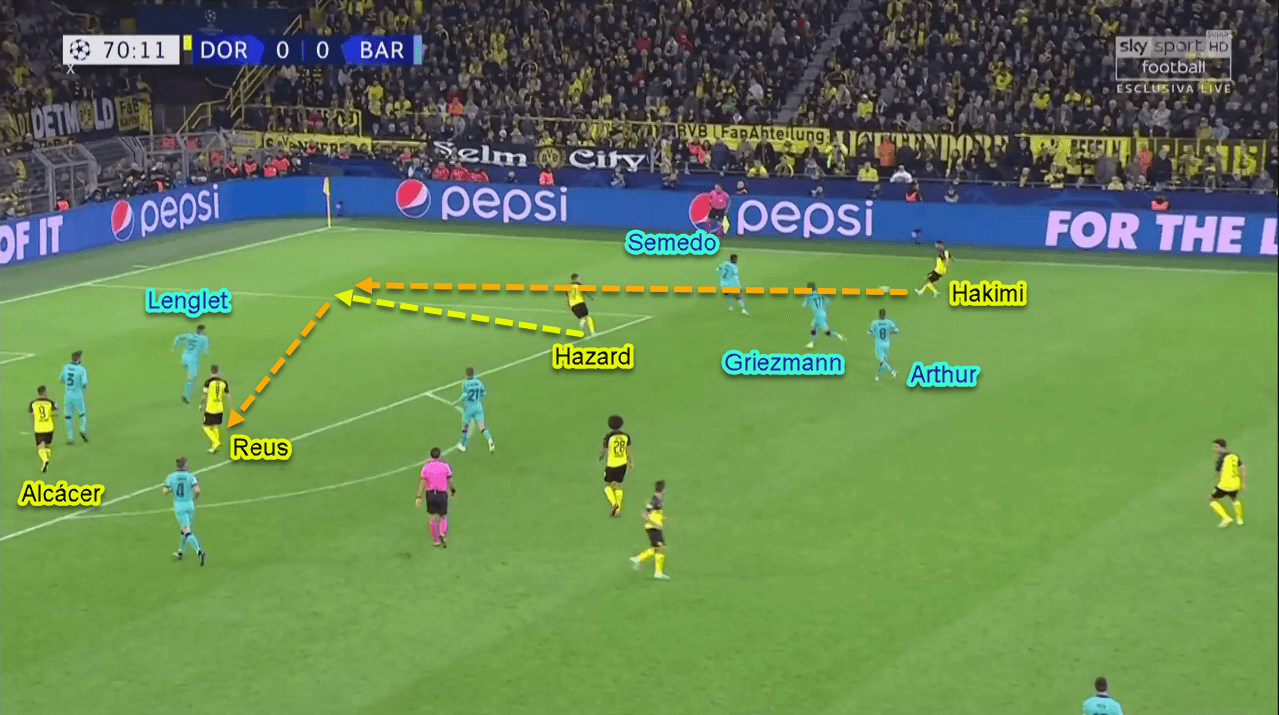
What’s worth mentioning is that Dortmund used this approach especially in the transitional period. By doing that, they could attack with pace and unpredictability against Barcelona’s not-yet-organised defence.
The Yellow Wall: heavy half-space protection
As mentioned in this analysis before, Dortmund were very solid defensively. Not only by squeezing the space in between the lines, but they were also very good when sitting deep in their area. When sitting deep just in front of their box, Dortmund’s focus was to protect the half-space heavily.
The objective of this approach was to contain Barcelona’s players’ run inside the half-space: either by preventing the pass to be made, intercepting the ball, or making a last-ditch block inside the box. They protected their half-spaces with two approaches.
First was with one of their defensive midfielders. When the opponent’s winger got the ball in the flank, Dortmund’s full-back would follow to face him in 1 v 1 duel. Behind him, the centre-back stayed in the central lane, thus opening the half-space for one of Barcelona’s midfielder, who would notice the gap and attack it. One of the pivots then would fill in the vacated area, therefore able to contain the roaming Barcelona’s midfielder.
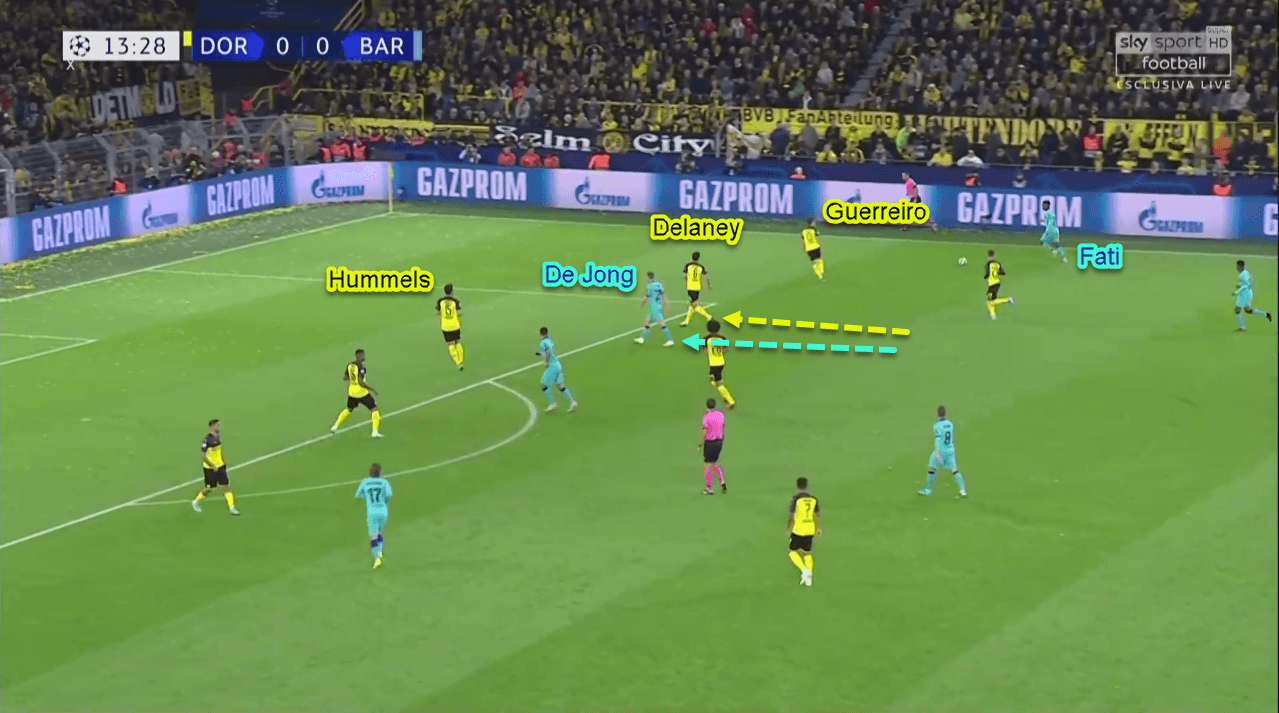
The second was with their ball-near winger. When Barcelona’s winger chose to move inside, Dortmund’s full-back would follow him and prevent him from making a turn in between the lines. This movement would open space in the flank for Barcelona’s full-back to attack. The ball-near Dortmund winger then would drop next to the full-back, thus making him able to contain the roaming Barcelona’s full-back.
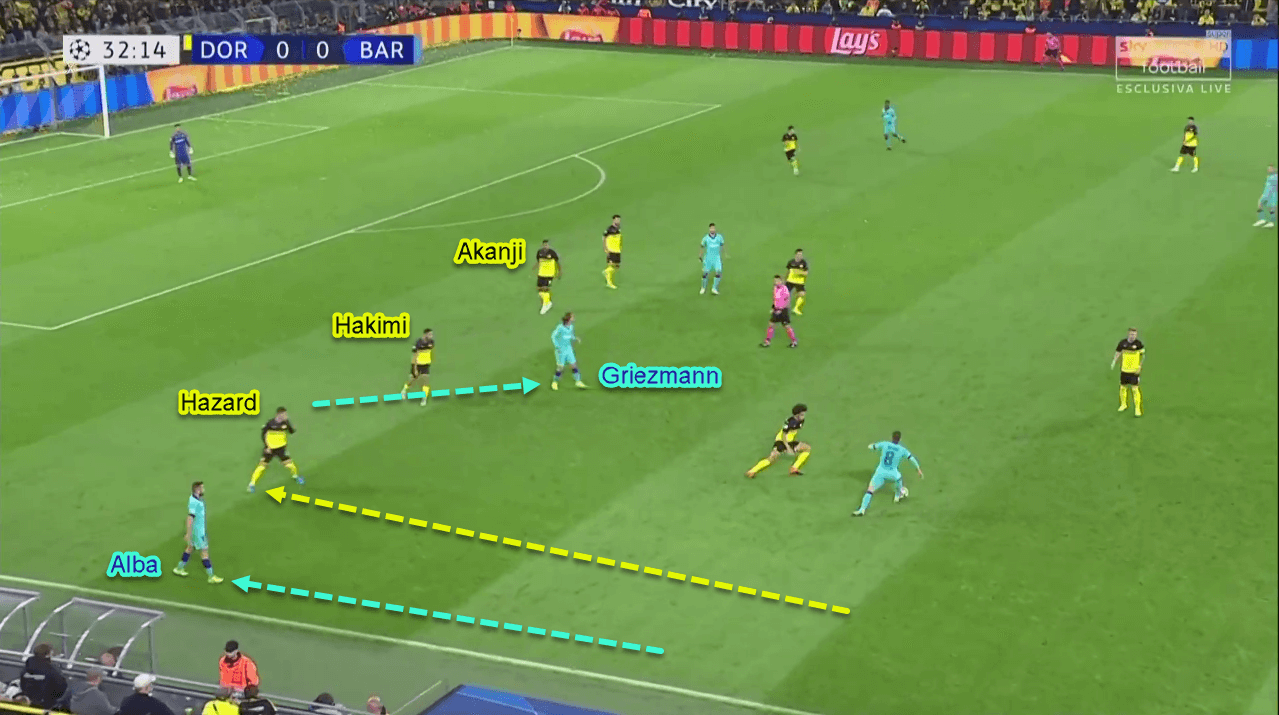
Barcelona’s offensive issues
Apart from their creativity in between the lines, Barcelona had almost nothing left in their arsenal. There were so many things lacking from Barcelona’s offensive point of view.
First, there were not enough diagonal passes or switches to disrupt Dortmund’s defence. Although Alba was constantly making his trademark runs in the left flank, none of Barca’s midfielders would find him with an over-the-top ball in behind- just like Messi always does to him. On the few occasions where the diagonal pass was made, it would be inaccurate and reduced the threat massively.
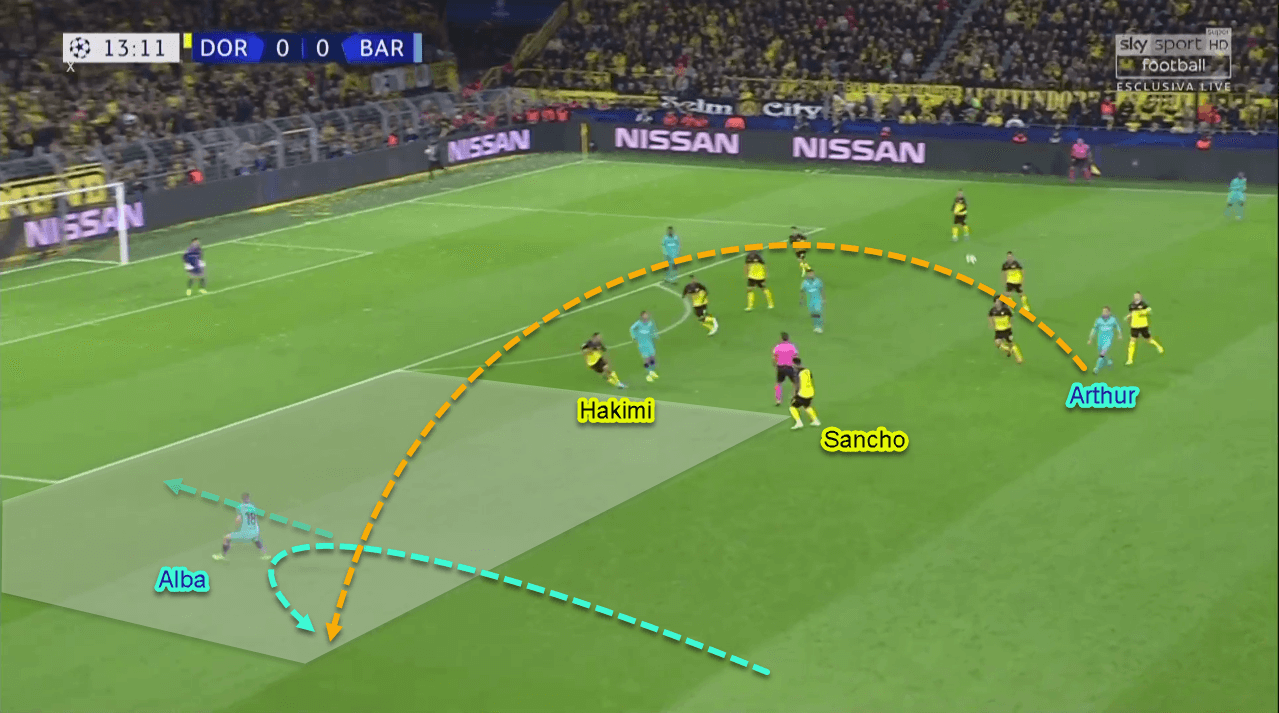
The objective of a switch is to release the ball-far player either free in space or free to make a 1 v 1 duel against the opponents’ defender; both to exploit the opponents’ defensive line when they were reorganising.
As Barcelona’s failure to obtain the first objective was already mentioned above, their failure to obtain the second was because of their midfielders’ poor decision making. Sometimes, the switch pass made by Arthur or De Jong was very late. The winger would already be closed down by two Dortmund players when he received the ball, therefore reducing his threat and allowing Dortmund’s defensive line to reorganise.
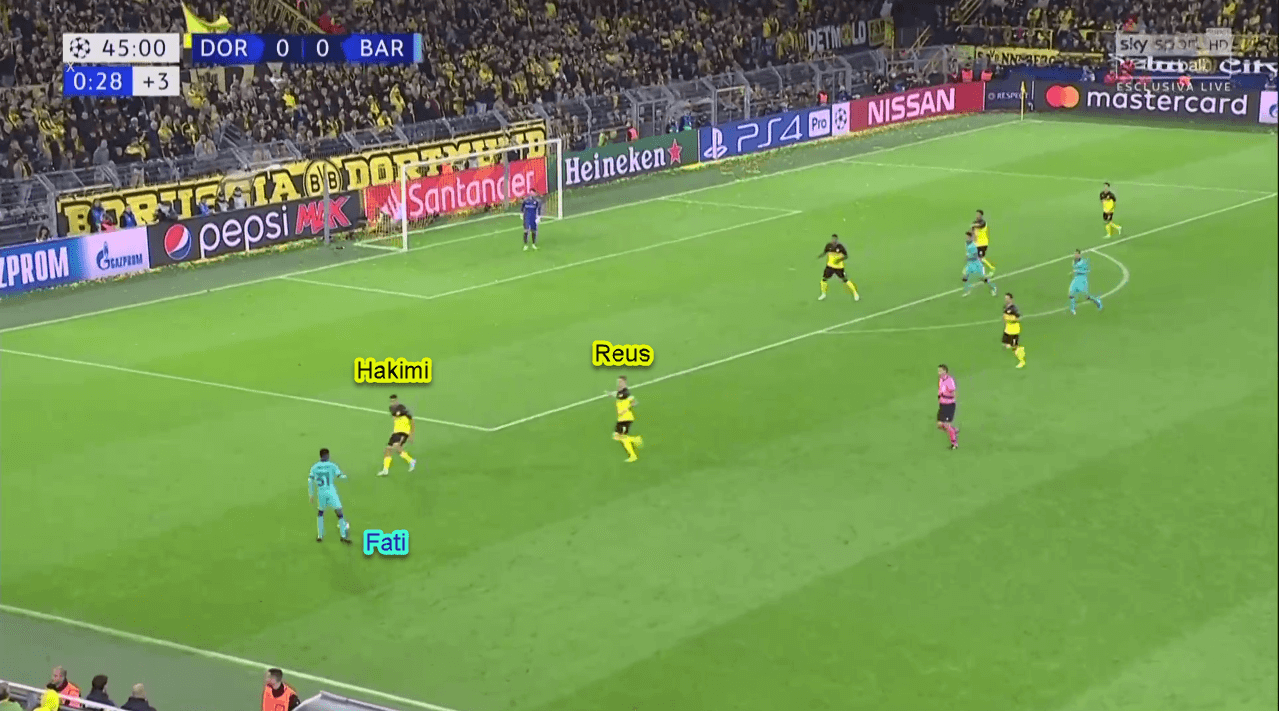
Second, there were not many through-balls in behind. Barcelona had explosive players like Suárez, Fati, Griezmann, Semedo, and Alba who like to play in behind. They did offer some runs in behind, but it seemed that the midfielders were not bold enough to pick the pass and rather chose to play more safely.
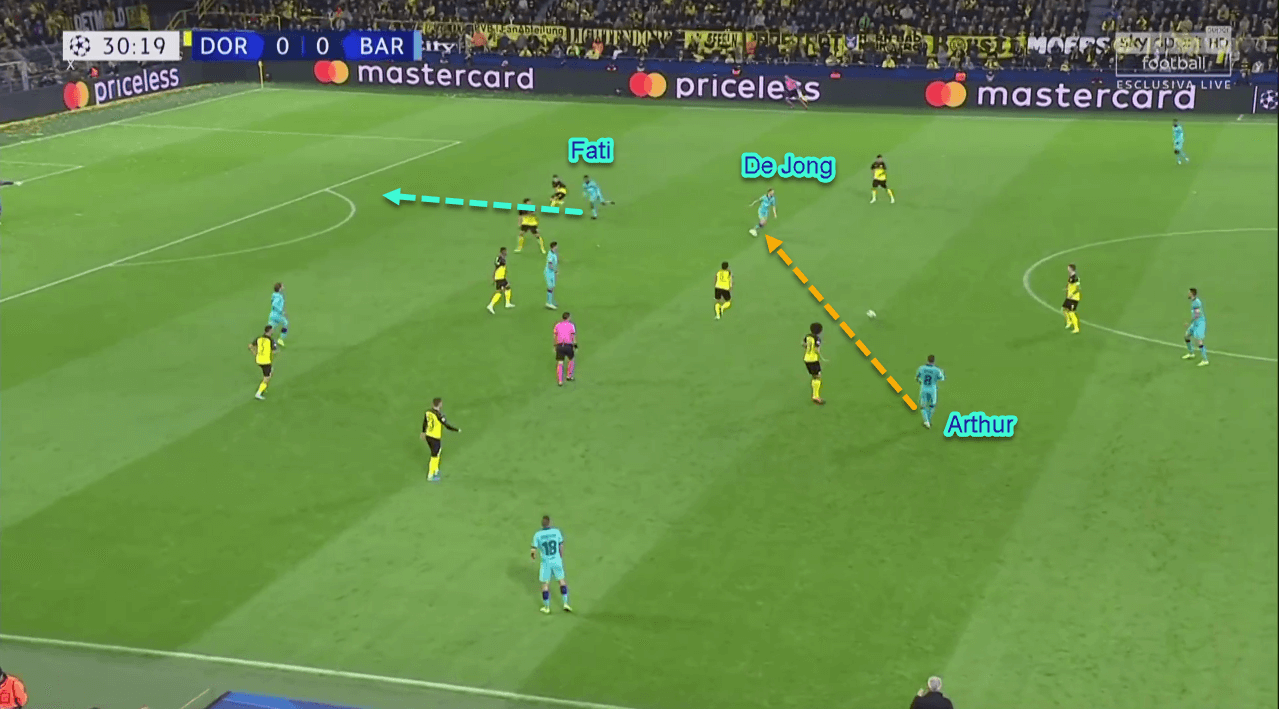
Barcelona got exploited in between the lines
In the previous part of this analysis, we mentioned that Barcelona were vulnerable in between the lines as Busquets — the lone defensive midfielder — had huge ground to cover. Later in the game, Barcelona moved to 4–4–2 and replaced Busquets with Rakitić who somehow was positioned in the right flank, leaving Arthur and De Jong with little defensive cover.
It was only Dortmund’s lack of players in that area that gave Barcelona few problems to face in the first half. Favre’s creative brain came into play as he made some tactical changes to exploit that area. Here’s how his Dortmund exploited the sacred space.
First, Favre instructed his full-backs to make driving diagonal runs into the space in between the lines, with Guerreiro as the main outlet. Guerreiro possesses a fine ball-carrying ability and is strong in 1 v 1 duel, which enabled him to access the area with a huge threat.
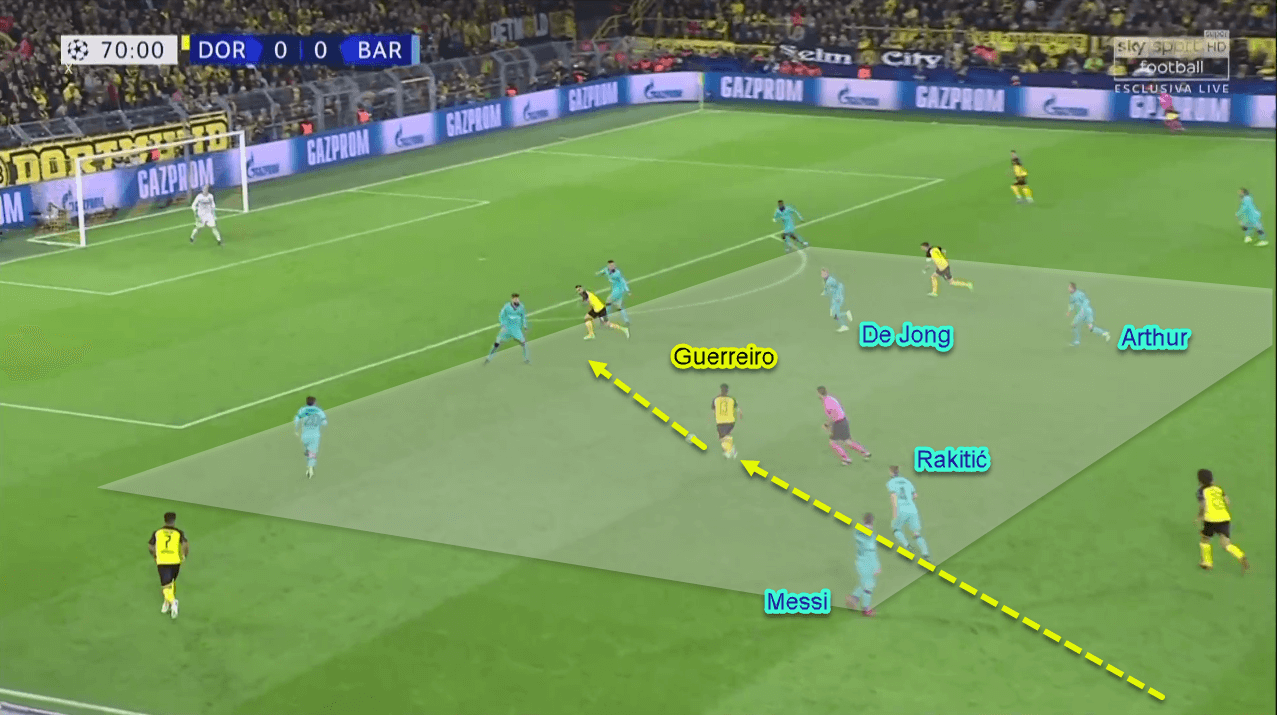
Second and finally, Favre instructed his wingers to come inside and make an overload in between the lines. When the full-back or the winger arrived, they could combine with Reus or Alcácer in the central lane, or creating a chance for themselves. One of Dortmund’s most dangerous chances in the second half came from this situation, where Brandt was given the time and space to drive and shoot with little to no pressure from Barcelona players.
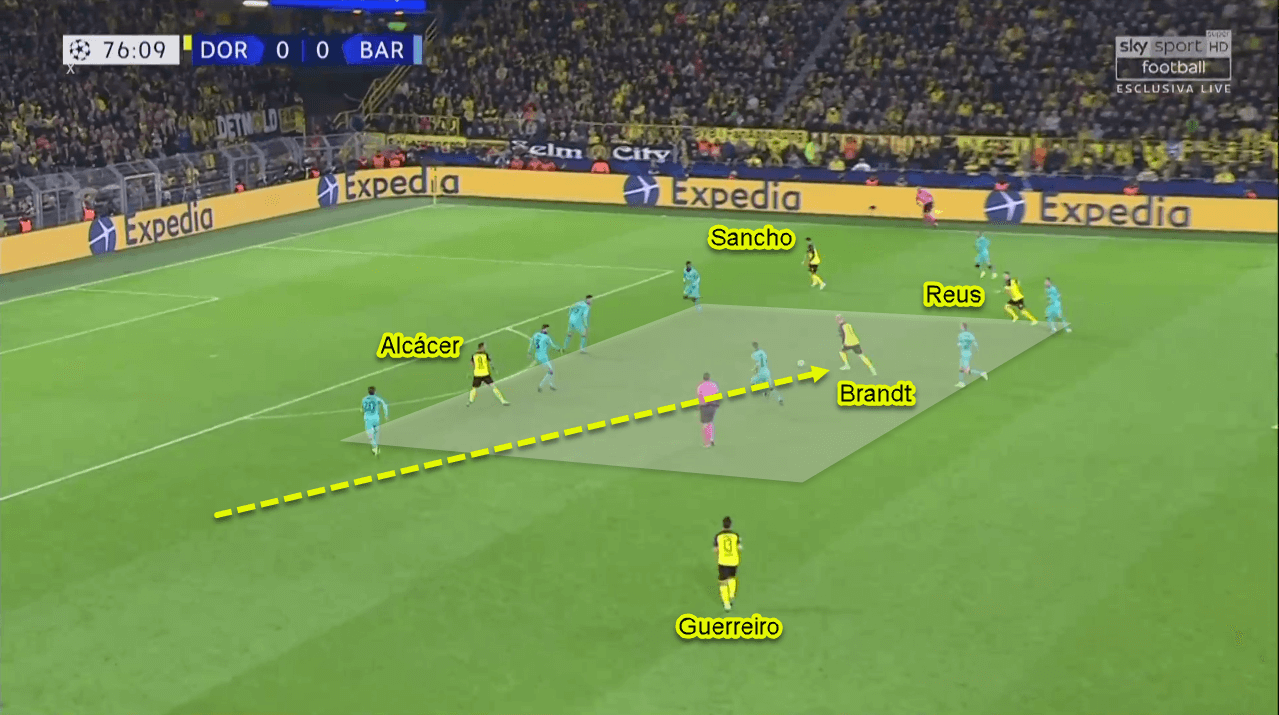
Conclusion
Zero goals, but a lot of tactical insights. Favre’s defensive adjustments proved effective to shut Barcelona’s down. In the other side, his offensive tactical imagination would be very fruitful had Reus and co. brought their shooting boots in this game.
Oppositely, questions must be asked to Valverde for his over-reliance on Messi not to mention his rather safe offensive approach. Judging by this match, there’s no wonder why Barcelona are struggling early this season. Valverde needs to work on his tactics and creativity to bring European glory to Camp Nou in May.
Let’s wait and see.

If you love tactical analysis, then you’ll love the digital magazines from totalfootballanalysis.com – a guaranteed 100+ pages of pure tactical analysis covering topics from the Premier League, Serie A, La Liga, Bundesliga and many, many more. Buy your copy of the August issue for just ₤4.99 here





Comments